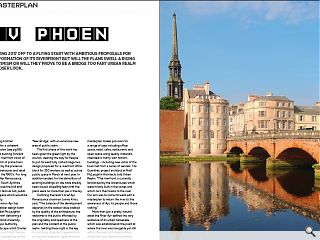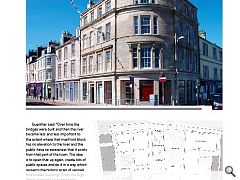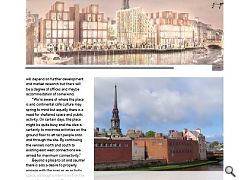River Phoenix: Ayr Masterplan
11 Jan 2017
Ayr is getting 2017 off to a flying start with ambitious proposals for the transformation of its riverfront but will the plans swell a rising tide of optimism or will they prove to be a bridge too far? Urban realm takes a closer look.
Whilst its metro big brother Glasgow fumbles for a coherent waterfront masterplan Ayr Renaissance is pushing forward with an ambitious riverfront vision of their own for a patch of prime town centre land sullied by the presence of overbearing warehouses and retail barns dating from the 1960’s. For long a local sore point Ayr Renaissance, a body formed by South Ayrshire Council, plan to excise the boil and build a destination festival hall, public realm and office space which would be the envy of any city.To realise this vision Ayr has turned to a high caliber design team spearheaded by Niall McLaughlin Architects, fresh from delivering a masterplan for Oxford University and London Olympic Authority, together with landscape artist Charles Jencks and delivery architect Keppie. Together they will oversee the revival of a prime parcel of land bounded by the medieval ‘Auld Brig’ and Victorian ‘New Bridge’, with an extensive new area of public realm.
The first phase of this work has been given the green light by the council, clearing the way for Keppie to put forward fully costed stage two design proposals for a riverfront office block for 350 workers as well as active public space in March of next year. In addition tenders for the demolition of existing buildings on site have already been issued, dispelling fears that the plans were no more than pie in the sky.
Outlining the team’s brief Ayr Renaissance chairman James Knox, said, “The balance of the development depends on the added value created by the quality of the architecture, the welcome to the public afforded by the originality and openness of the plan and the content of the public realm. Getting these right is the key to unlocking long-term regeneration of the town centre for generations to come.”
To that end the indicative masterplan makes provision for a range of uses including office space, retail, cafes, restaurants and open space using quality materials, intended to marry with historic buildings – including new vistas of the town hall from a series of vennels. Tilo Guenther, project architect at Niall McLaughlin Architects told Urban Realm: “The riverfront is currently landlocked by the warehouses which were mostly built in the sixties and which turn their backs to the river. Our aim was to come forward with a masterplan to return the river to the awareness of Ayr, its people and those visiting.”
More than just a pretty natural asset the River Ayr defines the very existence of its urban namesake, which was established at the point at where the river was navigable yet still within the reach of bridge builders. Since then the riverfront has fallen victim to a slow, sad, decline leading us to the present situation.
Guenther said: “Over time the bridges were built and then the river became less and less important to the extent where that riverfront block has no elevation to the river and the public have no awareness that it exists from that part of the town. The idea is to open that up again, create lots of public spaces and do it in a way which respects the historic grain of vennels and smaller buildings. From the High Street there will be a large town square which connects diagonally with a river square which opens out towards the river and provides a new area of public space where people can mingle.
“The heart of the development is a public festival building which may host temporary events to bring activity that is adjacent to both squares with buildings to either side with stepped gables to offer a recognisable river elevation.” Intended to be read as a modern interpretation of crow-stepped gables and the nautical style found in the Baltic states and Hanseatic cities the look is at once modern while remaining rooted in the past.
Stressing that this is a masterplan concept and far from a finished architectural design Guenther stated that the idea had been to proceed with a mono-pitched structure. “We thought it could be a highly-glazed building with the sun filtering through to animate the space through coloured glass”, he said. “The uses of the buildings are not fully defined and will depend on further development and market research but there will be a degree of offices and maybe accommodation of some kind.
“We’re aware of where the place is and continental café culture may spring to mind but equally there is a need for sheltered space and public activity. On certain days, the place might be quite busy and the idea is certainly to maximise activities on the ground floor to attract people onto and through the site. By continuing the vennels north and south to existing east west connections we aimed for maximum connectivity.”
Beyond a place to sit and saunter there is also a desire to properly engage with the river as an activity space, although a marina isn’t on the cards. Guenther said: “People got really excited about using the river and the two embankments either side as an events space to make the river itself an activity space with festivals or races.”
Over the longer term, it is hoped to extend the River Ayr walkway from the Auld Brig through the site and onward to the sea as well as re-landscaping the north shore to provide a more appropriate backdrop to the events space, flanked by the grand sweeping arms of both bridges. Before that can happen however a full planning application, which isn’t expected until early next year, must be approved, which would in turn enable demolition works to commence alongside an archaeological dig. From there the project is structured in such a way to allow phased implementation from east to west or west to east.
Should Ayr’s back to the future vision come to pass a corner of the town once defined by bustling wharves and narrow closes, all thought to have been consigned to the past, could find itself thrust into the forefront of the town’s future. Before that can happen however the bigger problem of bridging ambition to reality must be crossed and it remains to be seen if this proves to be a bridge too far.
|
|
Read next: Broomielaw District: Central Planning
Read previous: Architecture in Crisis: Rotten Burghs
Back to January 2017
Browse Features Archive
Search
News
For more news from the industry visit our News section.
Features & Reports
For more information from the industry visit our Features & Reports section.





